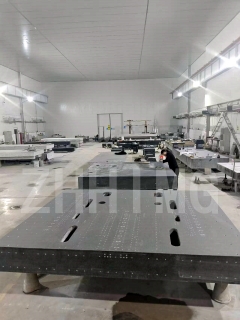Coordinate measuring machines (CMM) have become an integral part of quality control processes in various industries. The accuracy and precision of CMM depend on several factors – one of which is the design of granite components. Granite components, including granite base, columns, and plate, are the essential components in CMM. The design of these components influences the machine's overall measurement efficiency, repeatability, and accuracy. Therefore, optimizing the design of granite components can further improve the measurement efficiency of CMM.
Here are some ways to optimize the design of granite components to enhance the performance of CMM:
1. Improve the Granite's Stability and Rigidity
Granite is the material of choice for CMM because of its excellent stability, rigidity, and natural damping properties. Granite exhibits low thermal expansion, vibration dampening, and high stiffness. However, even slight variations in the physical properties of granite components can result in measurement deviations. Therefore, to ensure the stability and rigidity of granite components, the following things should be taken care of:
- Choose high-quality granite with consistent physical properties.
- Avoid introducing stress on the granite material during machining.
- Optimize the structural design of granite components to improve stiffness.
2. Optimize the Geometry of Granite Components
The geometry of granite components, including base, columns, and plate, plays a crucial role in the measurement accuracy and repeatability of CMM. The following design optimization strategies can help enhance the geometric accuracy of granite components in CMM:
- Ensure that the granite components are symmetrical and are designed with proper alignment.
- Introduce appropriate chamfers, fillets, and radii in the design to reduce stress concentration, improve the natural damping of the structure, and prevent corner wear.
- Optimize the size and thickness of the granite components according to the application and machine specifications to avoid deformations and thermal effects.
3. Enhance the Surface Finish of Granite Components
The roughness and flatness of the granite components' surface have a direct impact on the measurement accuracy and repeatability of CMM. A surface with high roughness and waviness can cause small errors that can accumulate over time, leading to significant measurement errors. Therefore, the following steps should be taken to enhance the surface finish of granite components:
- Use sophisticated machining technologies to ensure that the granite components' surfaces are smooth and flat.
- Reduce the number of machining steps to limit the introduction of stress and deformations.
- Regularly clean and maintain the surface of granite components to prevent wear and tear, which can also influence the measurement accuracy.
4. Control the Environmental Conditions
Environmental conditions, such as temperature, humidity, and air quality, can also affect the measurement accuracy and repeatability of CMM. To minimize the impact of environmental conditions on the granite components' accuracy, the following measures should be taken:
- Use a temperature-controlled environment to maintain the temperature of granite components.
- Provide adequate ventilation to the CMM area to prevent contamination.
- Control the relative humidity and air quality in the area to avoid the formation of condensation and dust particles that can adversely affect the measurement accuracy.
Conclusion:
Optimizing the design of granite components is a vital step in improving the measurement efficiency of CMM. By ensuring the stability, rigidity, geometry, surface finish, and environmental conditions of granite components, one can enhance the overall efficiency, repeatability, and accuracy of CMM. Additionally, regular calibration and maintenance of CMM and its components are also critical for ensuring proper functioning. The optimization of granite components will lead to better quality products, reduced waste, and increased productivity.
Post time: Apr-09-2024

